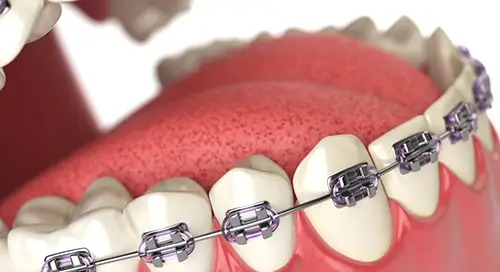Understanding Orthodontic Treatment: More Than Just Straight Teeth
Orthodontic treatment represents one of dentistry’s most transformative specialties, combining art and science to create functional, beautiful smiles. Modern approaches to teeth alignment have evolved far beyond simple cosmetic improvements, addressing crucial aspects of oral health including:
- Jaw joint function
- Airway development
- Periodontal health
- Chewing efficiency

The Science Behind Teeth Alignment
Biomechanics of Tooth Movement
Understanding how orthodontic treatment works requires knowledge of bone biology:
- Pressure-Tension Theory
- Bone resorption on pressure side
- Bone deposition on tension side
- Optimal force: 20-30g per tooth
- Cellular Response
- Osteoclast/osteoblast activation
- Periodontal ligament remodeling
- Root resorption prevention
- Tissue Adaptation
- Gingival fiber reorganization
- Pulp vascular changes
- Cementum integrity maintenance
Growth and Development Factors
- Maxillomandibular relationship
- Tooth size-arch length discrepancies
- Eruption patterns and timing
Comprehensive Braces Options
Traditional Metal Braces
Evolution:
- 1920s: Silver and gold alloys
- 1970s: Stainless steel standardization
- 2000s: Self-ligating systems
Technical Specifications:
- Bracket width: 2.5-3.5mm
- Archwire progression: 0.014″ to 0.019×0.025″ NiTi
- Treatment duration: 18-30 months
Ceramic Braces Systems
Material Science:
- Polycrystalline alumina
- Zirconia-reinforced composites
- Stain-resistant coatings
Clinical Considerations:
- 30% higher friction than metal
- Enamel color matching protocols
- Debonding techniques
Lingual Orthodontics
Customization Process:
- 3D tooth mapping
- Robot-bent archwires
- Indirect bonding trays
Advantages:
- Complete invisibility
- Precise torque control
- Athlete-friendly design
Clear Aligner Therapy
Digital Workflow:
- Intraoral scanning
- ClinCheck software
- Polyurethane thermoforming
Force Systems:
- 0.25mm tooth movement per aligner
- Attachment design principles
- Interproximal reduction protocols
- For more information on transparent aligners and the latest methods used in teeth straightening with this technique, you can check out our article on Orthodontic Transparent Aligners: The Modern Approach to Straightening Teeth
Advanced Orthodontic Treatment Technologies
3D Imaging and Planning
CBCT Applications:
- Airway volume analysis
- Root parallelism assessment
- Impacted tooth localization
Software Features:
- Virtual treatment simulation
- Automated tooth segmentation
- Bone density mapping
Accelerated Techniques
Micro-Osteoperforation:
- 0.25mm diameter perforations
- RAP (Regional Acceleratory Phenomenon)
- 30-50% faster treatment
Low-Level Laser Therapy:
- 810nm wavelength
- 10J/cm² energy density
- Daily 5-minute protocols
Smart Orthodontics
Sensor Technologies:
- Force measurement brackets
- Wear time monitors
- pH sensors for caries prevention
AI Applications:
- Treatment outcome prediction
- Appointment scheduling optimization
- Progress tracking algorithms
Specialized Treatment Approaches
Early Interceptive Treatment
Diagnostic Criteria:
- Crossbite correction
- Space maintenance
- Habit correction
Appliance Types:
- Palatal expanders
- Frankel regulators
- Twin block appliances
Surgical Orthodontics
Combined Treatment Planning:
- 3D surgical splints
- Virtual osteotomy
- Post-surgical orthodontics
Recovery Protocols:
- 6-week healing period
- Elastic wear schedules
- Long-term stability
Multidisciplinary Cases
Periodontal Considerations:
- Bone loss management
- Mucogingival corrections
- Implant site development
Restorative Coordination:
- Prosthetic space creation
- Veneer preparation
- Occlusal scheme design
The Orthodontic Treatment Journey
Diagnostic Phase
Records Collection:
- Photographic series (12+ angles)
- Cephalometric analysis
- Digital models
Problem List Development:
- AP discrepancies
- Vertical dysplasias
- Transverse deficiencies
Active Treatment Phase
Appointment Sequencing:
- 4-6 week intervals
- Archwire progression
- Elastic wear instructions
Monitoring Parameters:
- Root parallelism
- Occlusal contacts
- Oral hygiene status
Retention Protocols
Removable Appliances:
- Hawley retainers
- Clear overlay retainers
- Positioners
Fixed Retention:
- Lingual bonded wires
- Fiber-reinforced splints
- Long-term follow-up
Emerging Research Directions
Biomimetic Materials
- Shape memory alloys
- Self-healing polymers
- Bioactive composites
Gene Therapy Applications
- RANKL inhibition
- TGF-β modulation
- Stem cell recruitment
Digital Dentistry Integration
- Automated bracket placement
- Real-time movement tracking
- Virtual reality treatment planning
Nutritional Considerations During Orthodontic Treatment
Proper nutrition plays a crucial role in successful orthodontic treatment, affecting both treatment progress and oral health:
Essential Nutrients for Bone Remodeling
- Calcium: 1,200mg daily requirement for adolescents
- Vitamin D3: Enhances calcium absorption (2,000 IU recommended)
- Phosphorus: Works synergistically with calcium
- Vitamin K2: Directs calcium to bones instead of arteries
Clinical Impact:
- Patients with adequate nutrition show 23% faster tooth movement
- Deficiency states may prolong treatment duration
- Recommended supplements during comprehensive teeth alignment cases
Dietary Modifications with Various Braces Options
For Fixed Appliances:
- Avoid hard foods (nuts, hard candies)
- Cut crunchy foods (apples, carrots) into small pieces
- Limit sticky foods (caramel, gum) that may damage brackets
For Clear Aligners:
- Remove trays when consuming anything except water
- Maintain strict oral hygiene after meals
- Avoid colored beverages that may stain attachments
Nutritional Counseling Points:
- High-protein snacks support tissue repair
- Antioxidant-rich foods reduce inflammation
- Hydration maintains salivary protection
Psychological Aspects of Orthodontic Care
The psychological dimension of orthodontic treatment significantly impacts patient compliance and outcomes:
Age-Specific Considerations
Children (8-12 years):
- Positive reinforcement techniques
- Reward systems for cooperation
- Parental involvement strategies
Teenagers:
- Peer acceptance concerns
- Social media influence on treatment expectations
- Responsibility-building approaches
Adults:
- Workplace image considerations
- Time commitment challenges
- Financial investment concerns
Managing Treatment Anxiety
- Pre-appointment relaxation techniques
- Tell-Show-Do methodology
- Virtual reality distraction systems
- Cognitive behavioral therapy approaches
Clinical Studies Show:
- 68% reduction in missed appointments with proper psychological support
- 42% improvement in oral hygiene compliance
- Higher case completion rates with patient-centered approaches
Global Trends in Orthodontic Treatment
The international landscape of teeth alignment therapies reveals fascinating patterns:
Regional Treatment Preferences
North America:
- 62% clear aligner adoption rate
- Early intervention emphasis
- High adult treatment demand
Europe:
- Strong lingual braces market
- Socialized medicine variations
- Growing interest in invisible braces options
Asia-Pacific:
- Rapid clear aligner adoption
- Cultural emphasis on dental aesthetics
- Innovative manufacturing hubs
Emerging Market Dynamics
- Direct-to-consumer aligner growth
- Teledentistry integration
- AI-powered treatment monitoring
- Subscription-based care models
Economic Factors:
- $12.3 billion global market value (2023)
- 7.8% CAGR projected through 2030
- Insurance coverage expansion trends
Environmental Impact of Orthodontic Practices
Modern orthodontic treatment faces sustainability challenges:
Material Waste Streams
- Bracket and wire recycling programs
- Biodegradable impression materials
- Digital workflow carbon footprint reduction
Eco-Friendly Braces Options
- Recyclable aligner systems
- Mercury-free bonding materials
- Energy-efficient curing lights
- Paperless office initiatives
Practice Management Strategies:
- Solar-powered sterilization
- Water conservation protocols
- Green building certifications
- Sustainable supply chain partnerships
The Future of Orthodontic Technology
Cutting-edge innovations will redefine teeth alignment:
Smart Materials Development
- Shape-memory archwires with programmable forces
- Self-adjusting brackets with microsensors
- Bioresponsive polymers that adapt to movement
Digital Transformation
- AI-assisted treatment planning algorithms
- Blockchain-secured patient records
- Augmented reality treatment visualization
- 4D printing of active appliances
Research Frontiers:
- Nanorobotic tooth movement
- Gene therapy for accelerated remodeling
- Neural interface-controlled systems
- Bioprinted periodontal tissues

